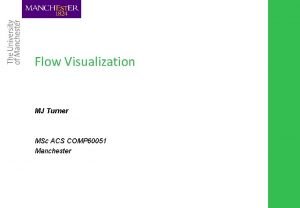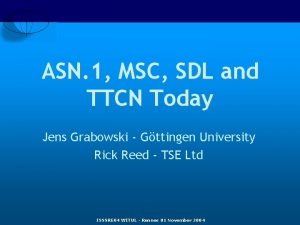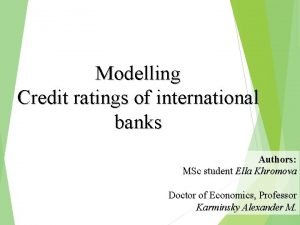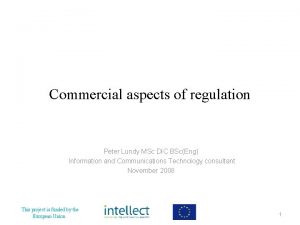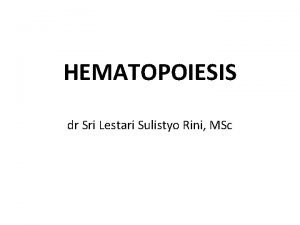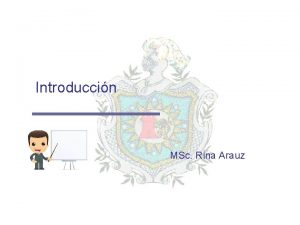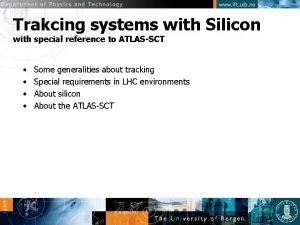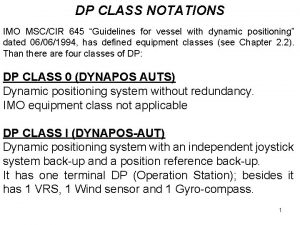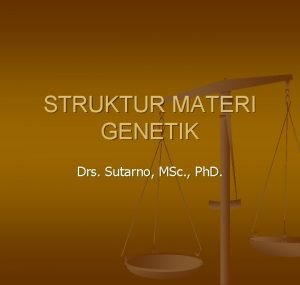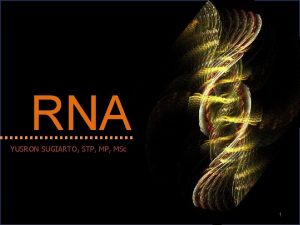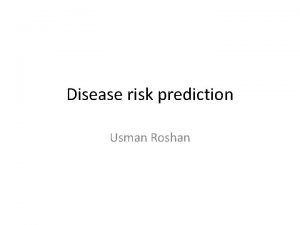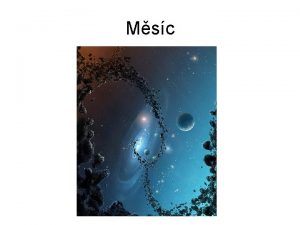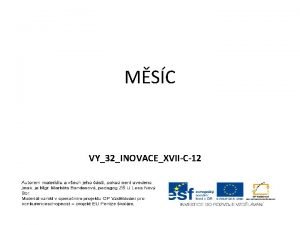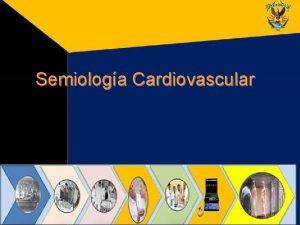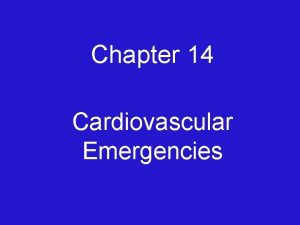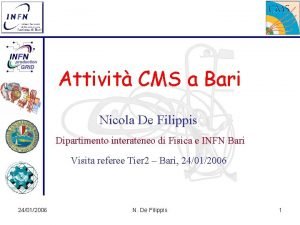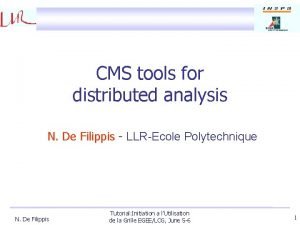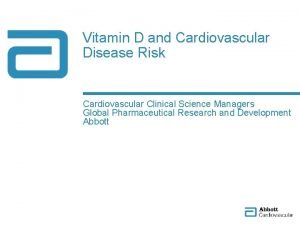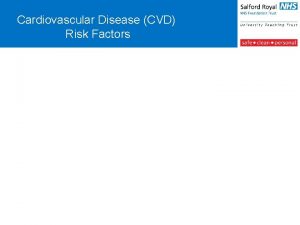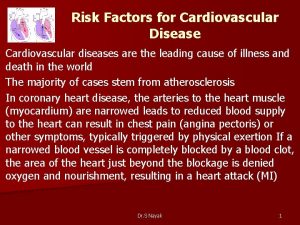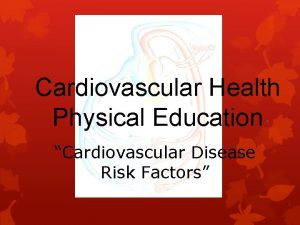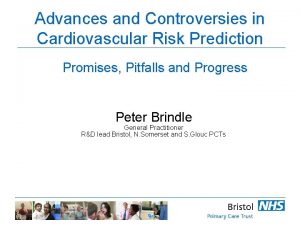CARDIOVASCULAR RISK PREDICTION Andrew De Filippis MD MSc































- Slides: 31

CARDIOVASCULAR RISK PREDICTION Andrew De. Filippis, MD, MSc University of Louisville and Johns Hopkins University

The Team Rebekah Young* University of Washington Chris J. Carrubba University of Colorado John W. Mc. Evoy Johns Hopkins Ciccarone Center for the Prevention of Heart Disease Matthew J. Budoff LA Biomedical Research Institute at Harbor-UCLA Medical Roger S. Blumenthal Johns Hopkins Ciccarone Center for the Prevention of Heart Disease Richard A. Kronmal, Ph. D University of Washington Robyn L. Mc. Clelland University of Washington Khurram Nasir Center for Prevention and Wellness Research, Baptist Health South Florida and Johns Hopkins Ciccarone Center for the Prevention of Heart Disease Michael J. Blaha Johns Hopkins Ciccarone Center for the Prevention of Heart Disease

What Is The Need? Accurate atherosclerotic cardiovascular disease (ASCVD) risk assessment is essential to effectively balance the risks and benefits of therapy in primary prevention. The applicability of many algorithms to modern populations has been questioned. � Based on a homogeneous, Caucasian-male dominated cohort from a prior generation. � Multiple studies in diverse populations suggest that Framingham-based risk scoring systems may misclassify and overestimate CHD risk.

What is Available Risk Score Target Cardiovascular Events Variables Included FRS- CHD Target Age Group 30 – 74 years Angina, MI, CHD death, coronary insufficiency FRS-CVD 30 – 74 years Angina, MI, CHD death, stroke, TIA, peripheral vascular disease, heart failure Age, Total Cholesterol, HDL-C, BP, Diabetes status, Smoking, Gender, Antihypertension Medication use ATP 3 -FRS-CHD >20 years MI, CHD death Age, Total Cholesterol, HDL-C, BP, Smoking, Gender, Antihypertension Medication use RRS Women 45 – 80 years MI, CHD death, stroke, coronary revascularization Age, Total Cholesterol, HDL-C, BP, Diabetes status, Smoking, Gender, hs-CRP, Family History, Hb. A 1 c (Female Diabetic Subjects only) MI, CHD death, stroke Age, Total Cholesterol, HDL-C, BP, Diabetes status, Smoking, Gender, White of African American Ethnicity, Antihypertension Medication use Men 50 – 80 years AHA-ACC-ASCVD 40 – 79 years

How Well Do These Model Work? Compare expected and observed event rates for each model in MESA (median 10. 2 yr F/U data) � Scores calculated from baseline MESA data (2000 -2002) � Limited to individuals age 50 -74 � Excluded those with baseline diabetes (12%) � Risk scores were adjusted for each participant's observed follow-up time using a compound interest formula when follow-up <10 years

How Well Do These Model Work? Hosmer-Lemeshow plots to evaluate how well each model fit the observed CVD events Multiple factors were evaluated in linear regression models as contributors discordance between observed and predicted. Sensitivity analysis: any treatment, DM, FH Discriminative capability evaluated using Harrell’s C statistic, ROC curves.

Predicted and Observed Events Risk score Expected # Events (%) Observed # Events (%) Harrell's C Discrimination slope Percent Discordance Men (n=1, 961) FRS-CHD 259 (13. 20) 164 (8. 36) 0. 68 0. 05 58 % FRS-CVD 369 (18. 80) 261 (13. 31) 0. 71 0. 09 41 % ATP 3 -FRS-CHD 221 (11. 28) 86 (4. 39) 0. 72 0. 05 157 % RRS 221 (11. 27) 196 (9. 99) 0. 69 0. 06 13 % AHA-ACC-ASCVD 240 (12. 23) 125 (6. 37) 0. 70 0. 05 92 % FRS-CHD 150 (6. 63) 99 (4. 37) 0. 59 0. 01 51. 5 % FRS-CVD 207 (9. 15) 187 (8. 25) 0. 70 0. 05 11 % ATP 3 -FRS-CHD 72 (3. 17) 48 (2. 12) 0. 67 0. 02 50 % RRS 104 (4. 58) 127 (5. 60) 0. 72 0. 04 -18 % AHA-ACC-ASCVD 160 (7. 04) 93 (4. 10) 0. 69 0. 05 72 % Women (n=2, 266)

Hosmer-Lemeshow Calibration Plots for Men (n=1, 961)

Hosmer-Lemeshow Calibration Plots for Women (n=2, 266)

Hosmer-Lemeshow Calibration Plot Data for Men FRS-CHD Group (range) Expected Observed HL Chi-Square Percentage Events (%) (10) Discordance* N 0 - <5% 175 6. 1 (3. 5) 4 (2. 3) 0. 76 52 5 – <7. 5% 296 18. 7 (6. 3) 10 (3. 4) 4. 35 85 7. 5 - <10% 336 29. 4 (8. 7) 14 (4. 2) 8. 83 107 <10% 1152 204. 6 (17. 8) 136 (11. 8) 27. 99 51 Total 1961 258. 9 (13. 2) 164 (8. 4) 41. 93 57

Hosmer-Lemeshow Calibration Plot Data for Men FRS-CVD Group (range) Expected Observed HL Chi-Square Percentage Events (%) (10) Discordance* N 0 - <5% 68 2. 3 (3. 4) 1 (1. 5) 0. 76 126 5 – <7. 5% 149 9. 5 (6. 4) 7 (4. 7) 0. 70 36 7. 5 - <10% 233 20. 7 (8. 9) 7 (3. 0) 9. 95 66 <10% 1511 336. 2 (22. 2) 246 (16. 3) 31. 12 36 Total 1961 368. 7 (18. 8) 261 (13. 3) 42. 52 41

Hosmer-Lemeshow Calibration Plot Data for Men ATP 3 -FRS-CHD Group (range) Expected Observed HL Chi-Square Percentage Events (%) (10) Discordance* N 0 - <5% 312 10. 7 (3. 4) 3 (1. 0) 5. 70 240 5 – <7. 5% 303 19. 0 (6. 3) 6 (2. 0) 9. 51 215 7. 5 - <10% 312 27. 2 (8. 7) 4 (1. 3) 21. 72 569 <10% 1034 164. 3 (15. 9) 73 (7. 1) 60. 29 124 Total 1961 221. 2 (11. 3) 86 (4. 4) 97. 22 157

Hosmer-Lemeshow Calibration Plot Data for Men RRS Group (range) Expected Observed HL Chi-Square Percentage Events (%) (10) Discordance* N 0 - <5% 505 16. 2 (3. 2) 17 (3. 4) 0. 04 -5. 9 5 – <7. 5% 338 21. 0 (6. 2) 21 (6. 2) 0. 00 0 7. 5 - <10% 271 23. 6 (8. 7) 18 (6. 6) 1. 44 32 <10% 847 160. 1 (18. 9) 140 (16. 5) 3. 10 14. 5 Total 1961 220. 9 (11. 3) 196 (10. 0) 4. 57 13

Hosmer-Lemeshow Calibration Plot Data for Men AHA-ACC-ASCVD Group (range) Expected Observed HL Chi-Square Percentage Events (%) (10) Discordance* N 0 - <5% 347 12. 1 (3. 5) 5 (1. 4) 4. 28 150 5 – <7. 5% 314 19. 6 (6. 2) 8 (2. 5) 7. 28 148 7. 5 - <10% 256 22. 2 (8. 7) 8 (3. 1) 9. 99 181 <10% 1044 185. 9 (17. 8) 104 (10. 0) 43. 91 78 Total 1961 239. 8 (12. 2) 125 (6. 4) 65. 46 91

Hosmer-Lemeshow Calibration Plot Data for Women FRS-CHD Group (range) Expected Observed HL Chi-Square Percentage Events (%) (10) Discordance* N 0 - <5% 927 31. 7 (3. 4) 29 (3. 1) 0. 24 9. 7 5 – <7. 5% 599 36. 6 (6. 1) 26 (4. 3) 3. 27 42 7. 5 - <10% 348 30. 0 (8. 6) 16 (4. 6) 7. 14 87 <10% 392 51. 9 (13. 2) 28 (7. 1) 12. 71 86 Total 2266 150. 2 (6. 6) 99 (4. 4) 23. 36 50. 0

Hosmer-Lemeshow Calibration Plot Data for Women FRS-CVD Group (range) Expected Observed HL Chi-Square Percentage Events (%) (10) Discordance* N 0 - <5% 694 22. 3 (3. 2) 19 (2. 7) 0. 49 18. 5 5 – <7. 5% 749 29. 5 (6. 2) 25 (5. 2) 0. 72 19 7. 5 - <10% 328 28. 4 (8. 7) 28 (8. 5) 0. 01 2. 4 <10% 765 127. 2 (16. 6) 115 (15. 0) 1. 41 11 Total 2266 207. 3 (9. 2) 187 (8. 3) 2. 63 10. 8

Hosmer-Lemeshow Calibration Plot Data for Women ATP 3 -FRS-CHD Group (range) Expected Observed HL Chi-Square Percentage Events (%) (10) Discordance* N 0 - <5% 1819 35. 1 (1. 9) 29 (1. 6) 1. 09 19 5 – <7. 5% 248 14. 9 (6. 0) 8 (3. 2) 3. 42 87. 5 - <10% 108 9. 3 (8. 6) 5 (4. 6) 2. 15 87 <10% 91 12. 6 (13. 8) 6 (6. 6) 3. 99 109 Total 2266 71. 9 (3. 2) 48 (2. 1) 10. 66 52. 4

Hosmer-Lemeshow Calibration Plot Data for Women RRS Group (range) Expected Observed HL Chi-Square Percentage Events (%) (10) Discordance* N 0 - <5% 1584 33. 0 (2. 1) 55 (3. 5) 15. 01 -40 5 – <7. 5% 271 16. 6 (6. 1) 16 (5. 9) 0. 02 3. 4 7. 5 - <10% 162 14. 0 (8. 6) 16 (9. 9) 0. 31 -13 <10% 249 40. 3 (16. 2) 40 (16. 1) 0. 00 0 Total 2266 103. 9 (4. 6) 127 (5. 6) 15. 35 -17. 9

Hosmer-Lemeshow Calibration Plot Data for Women AHA-ACCASCVD Group (range) Expected Observed HL Chi-Square Percentage Events (%) (10) Discordance* N 0 - <5% 1115 27. 0 (2. 4) 19 (1. 7) 2. 44 140 5 – <7. 5% 345 21. 2 (6. 1) 16 (4. 6) 1. 35 33 7. 5 - <10% 246 21. 5 (8. 7) 12 (4. 9) 4. 56 77. 5 <10% 560 90. 0 (16. 1) 46 (8. 2) 25. 63 96 Total 2266 159. 7 (7. 0) 93 (4. 1) 33. 98 70. 7

Linear Regression: Factors Predicting Discordance FRS-CHD Model 1 Model 2 FRS-CVD ATP 3 -FRS-CHD RRS AHA-ACC-ASCVD Model 1 Model 2 Treatment Aspirin 0. 10 -0. 00 0. 29* 0. 15 0. 37** 0. 04 0. 12 -0. 03 0. 34* 0. 04 (0. 13) (0. 11) (0. 13) (0. 12) (0. 13) (0. 08) (0. 14) (0. 10) 0. 09 1. 39*** 0. 33* 1. 47*** 0. 45*** 0. 44** -0. 41** 2. 43*** 0. 56*** (0. 13) (0. 12) (0. 13) (0. 09) (0. 15) (0. 14) (0. 11) 0. 26* -0. 21 0. 25 -0. 02 0. 45*** 0. 15 -0. 00 -0. 20 0. 23 -0. 00 (0. 13) (0. 12) (0. 13) (0. 09) (0. 15) (0. 14) (0. 10) 0. 79 -0. 20 -0. 43 -1. 21 1. 07** -0. 52* N/A 1. 31** 0. 28 (0. 73) (0. 62) (0. 82) (0. 72) (0. 39) (0. 24) N/A (0. 41) (0. 29) Anti-hypertensive 0. 92*** Lipid-lowering Revascularization Dependent variable is the discordance between the observed and expected probabilities Standard errors in parenthesis. *p<0. 05. **p<0. 01. ***p<0. 001. n=4, 227 Model 1: multivariable model of aspirin, anti-hypertensive and lipid lowering medication and revascularization Model 2: consistent use of aspirin, anti-hypertensive medication or lipid lowering medication at any time during the study, age, revascularization, gender (M), ethnicity, systolic blood pressure, total cholesterol, HDL cholesterol, smoking.

Linear Regression: Factors Predicting Discordance FRS-CHD Model 1 Model 2 FRS-CVD Model 1 Model 2 ATP 3 -FRS-CHD Model 1 Model 2 RRS AHA-ACC-ASCVD Model 1 Model 2 0. 11*** 0. 12*** 0. 19*** 0. 09*** 0. 28*** (0. 01) 2. 22*** 2. 11*** 4. 68*** 0. 96*** 2. 28*** (0. 12) (0. 09) (0. 14) (0. 10) -0. 02 -0. 09 -0. 53* -0. 03 (0. 18) (0. 19) (0. 13) (0. 22) (0. 16) -0. 03 0. 17 -0. 23* -0. 29 0. 57*** (0. 14) (0. 10) (0. 17) (0. 12) -0. 23 0. 10 -0. 02 -0. 27 -0. 32* (0. 15) (0. 11) (0. 18) (0. 13) Demographics Age (per year) Male Chinese Black Hispanic Dependent variable is the discordance between the observed and expected probabilities Standard errors in parenthesis. *p<0. 05. **p<0. 01. ***p<0. 001. n=4, 227 Model 1: multivariable model of aspirin, anti-hypertensive and lipid lowering medication and revascularization Model 2: consistent use of aspirin, anti-hypertensive medication or lipid lowering medication at any time during the study, age, revascularization, gender (M), ethnicity, systolic blood pressure, total cholesterol, HDL cholesterol, smoking.

Linear Regression: Factors Predicting Discordance FRS-CHD Model 1 Model 2 FRS-CVD Model 1 Model 2 ATP 3 -FRS-CHD Model 1 Model 2 RRS Model 1 Model 2 AHA-ACC-ASCVD Model 1 Model 2 Risk factors SBP/10 Total cholesterol/10 HDL/10 Smoker 0. 44*** 0. 50*** 0. 47*** 0. 41*** 0. 68*** (0. 03) (0. 02) (0. 04) (0. 03) 0. 24*** 0. 15*** 0. 07*** 0. 08*** (0. 02) (0. 01) -0. 65*** -0. 36*** -0. 50*** -0. 28*** -0. 32*** (0. 04) (0. 03) (0. 05) (0. 03) 1. 59*** 1. 84*** 1. 61*** 1. 04*** 2. 16*** (0. 16) (0. 12) (0. 20) (0. 14) Dependent variable is the discordance between the observed and expected probabilities Standard errors in parenthesis. *p<0. 05. **p<0. 01. ***p<0. 001. n=4, 227 Model 1: multivariable model of aspirin, anti-hypertensive and lipid lowering medication and revascularization Model 2: consistent use of aspirin, anti-hypertensive medication or lipid lowering medication at any time during the study, age, revascularization, gender (M), ethnicity, systolic blood pressure, total cholesterol, HDL cholesterol, smoking.

Linear Regression: Factors Predicting Discordance FRS-CHD FRS-CVD ATP 3 -FRS-CHD RRS AHA-ACC-ASCVD Model 1 Model 2 Intercept R-squared Model 1 Model 2 2. 75*** -10. 95*** 1. 94*** -13. 39*** 2. 47*** -16. 72*** -0. 30* -10. 55*** 2. 51*** -23. 22*** (0. 11) (0. 62) (0. 12) (0. 65) (0. 11) (0. 46) (0. 13) (0. 77) (0. 12) (0. 56) 0. 017 0. 299 0. 034 0. 269 0. 049 0. 634 0. 003 0. 093 0. 089 0. 526 Dependent variable is the discordance between the observed and expected probabilities Standard errors in parenthesis. *p<0. 05. **p<0. 01. ***p<0. 001. n=4, 227 Model 1: multivariable model of aspirin, anti-hypertensive and lipid lowering medication and revascularization Model 2: consistent use of aspirin, anti-hypertensive medication or lipid lowering medication at any time during the study, age, revascularization, gender (M), ethnicity, systolic blood pressure, total cholesterol, HDL cholesterol, smoking.

Sensitivity Analysis: No Therapy Expected # Events (%) Observed # Events (%) Percentage Discordance Harrell's C Discrimination slope FRS-CHD 41 (10. 56) 10 (2. 55) 76% 0. 76 0. 06 FRS-CVD 52 (13. 29) 13 (3. 32) 75% 0. 71 0. 07 ATP 3 -FRS-CHD 32 (8. 29) 9 (2. 30) 255% 0. 74 0. 05 RRS 30 (7. 76) 11 (2. 81) 173% 0. 71 0. 05 AHA-ACC-ASCVD 33 (8. 38) 11 (2. 81) 200% 0. 75 0. 05 Risk score Men (n=392) Women (n=398) FRS-CHD 19 (4. 80) 2 (0. 50) 850% 0. 62 0. 01 FRS-CVD 20 (4. 93) 5 (1. 26) 300% 0. 82 0. 03 ATP 3 -FRS-CHD 6 (1. 51) 1 (0. 25) 500% 0. 58 0. 01 RRS 9 (2. 21) 3 (0. 75) 200% 0. 77 0. 06 AHA-ACC-ASCVD 14 (3. 56) 3 (0. 75) 366% 0. 67 0. 04

Predicted and observed events among never treated men and women Discriminatio Percentage Expected # Observed # Risk score Events (%) Harrell's C Men (n=392) FRS-CHD 41 (10. 56) 10 (2. 55) 0. 76 0. 06 76% FRS-CVD 52 (13. 29) 13 (3. 32) 0. 71 0. 07 75% ATP 3 -FRS-CHD 32 (8. 29) 9 (2. 30) 0. 74 0. 05 255% RRS 30 (7. 76) 11 (2. 81) 0. 71 0. 05 173% 0. 75 0. 05 200% AHA-ACC- n Discordance Slope ASCVD 33 (8. 38) 11 (2. 81) Women (n=398) FRS-CHD 19 (4. 80) 2 (0. 50) 0. 62 0. 01 850% FRS-CVD 20 (4. 93) 5 (1. 26) 0. 82 0. 03 300% ATP 3 -FRS-CHD 6 (1. 51) 1 (0. 25) 0. 58 0. 01 500%

ROC: Men

ROC: Women

Limitations The RRS for men and the ATP 3 -FRS-CHD risk score were not developed for risk calculation among diabetics Sensitivity analysis reveled little change Missed events Methods for ascertainment of events similar in MESA to that of the studies used to derive the risk scores Preliminary analysis of the CMS data suggests that no more than 15% of MIs and strokes could have been missed in MESA.

Limitations Healthy Cohort Effect Subjects who enroll in research studies may be more health conscious with better general health practices. This limitation is shared by all of the studies used to derive risk score models and is not unique to MESA. In a modern study of randomly selected adult subjects enrolled between 2000 and 2003 from the metropolitan Ruhr area in Germany, the FRS overestimated risk by more than 2 fold in the 93% of subjects free of CAD at baseline.

Summary of Data The new AHA-ACC-ASCVD and three related older risk scores overestimated cardiovascular events by 58 -157% in men and 11 -72% in women. Overestimation was noted throughout the continuum of risk, including low and intermediate risk individuals. RRS overestimated risk by 13% in men but underestimated risk by 18% in women. Greater age, male gender, systolic blood pressure, antihypertensive therapy, total cholesterol, low HDL-C, and smoking were significant predictors of risk overestimation while aspirin, lipid lowering and coronary revascularization therapy were not. The C-statistic for the AHA-ACC-ASCVD risk score was comparable to the other risk scores (0. 70 in men, 0. 69 in women).

Implications Overestimation of risk would likely result in over use of preventive medications, exposing some patients to the unnecessary risks of these drugs. Cholesterol management guidelines recommend consideration of statin therapy in individuals with a AHA-ACC-ASCDV risk calculation >7. 5%. Aspirin use in primary prevention is known to be a delicate balance between cardiovascular risk reduction and an increased incidence of bleeding. Financial burden for individual patients and the entire healthcare system.
 Graciela de filippis
Graciela de filippis Cardiovascular disease risk factor
Cardiovascular disease risk factor Market risk credit risk operational risk
Market risk credit risk operational risk Msc acs
Msc acs 2vision msc
2vision msc Msc finance and banking tor vergata
Msc finance and banking tor vergata Vdoe msc
Vdoe msc Msc marianna
Msc marianna Msc
Msc Msc construction law and dispute resolution
Msc construction law and dispute resolution Marc ruttenberg
Marc ruttenberg Msc credit rating
Msc credit rating What is an msc?
What is an msc? Local loop
Local loop Msc eir
Msc eir Msc pelago
Msc pelago Scan barcode msc
Scan barcode msc Phsc in erythropoiesis
Phsc in erythropoiesis University of birmingham msc international business
University of birmingham msc international business Msc direccionamiento
Msc direccionamiento Msc
Msc Trakcing
Trakcing Fibrinolysis pathway
Fibrinolysis pathway Msc definition
Msc definition Solid-state lighting (ssl)
Solid-state lighting (ssl) Dp imo 100
Dp imo 100 Struktur msc
Struktur msc Msc olga
Msc olga Msc sirkka
Msc sirkka Dogma msc
Dogma msc Meteorological satellite center of jma
Meteorological satellite center of jma Almacenes msc
Almacenes msc



